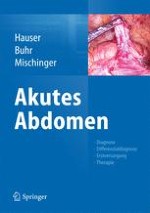Zusammenfassung
Die Auswirkung der retroperitonealen Blutung bzw. des retroperitonealen Hämatoms reicht vom kleinen klinischen, vielleicht unbemerkten, bis zum intensivpflichtigen Ereignis. Entsprechend uncharakteristisch können dadurch die Symptome sein. Retroperitoneale Hämatome lassen sich in drei Gruppen einteilen: spontane retroperitoneale Hämatome ohne traumatischen Hintergrund, iatrogen bedingte und posttraumatische retroperitoneale Hämatome. Das spontane retroperitoneale Hämatom sollte primär konservativ behandelt werden. Beim iatrogen bedingten Hämatom kann die endovaskuläre Therapie als weitere Option einer initial offenen Revision vorgeschaltet werden. Beim traumatisch bedingten Hämatom sind konservative oder operative Vorgehensweisen im Wesentlichen vom Mechanismus des Traumas, vom Ausmaß zusätzlicher Verletzungen und vom klinischen Verlauf abhängig. Alle möglichen Therapieformen reflektieren einen wesentlichen Aspekt im Management des retroperitonealen Hämatoms: die Interdisziplinarität.











